CLIMATE CHANGE , SO WHAT'S NEW
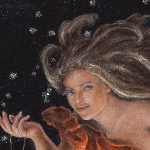





Thumbnails of Paintings On This Page
Explore the theories beneath these painting
THE BERING STRAIT DIKE FUND
Add Your Heading Text Here
Description of the Painting
The Arctic Ocean and the Bering Strait are the backdrop for Europa’s flight. She holds a snow globe and a pocket watch set at 5 minutes to midnight, symbolizing the brief time the Arctic Ocean will retain its summer ice.
The blue and gold ceiling of Notre Dame Church in Montreal inspires the frame’s style and colors. For many years, collection boxes were standard in Montreal. The corner stores and restaurants that collected donations for the Saint Joseph’s Oratory inspired the collection box incorporated into the bottom of the frame.
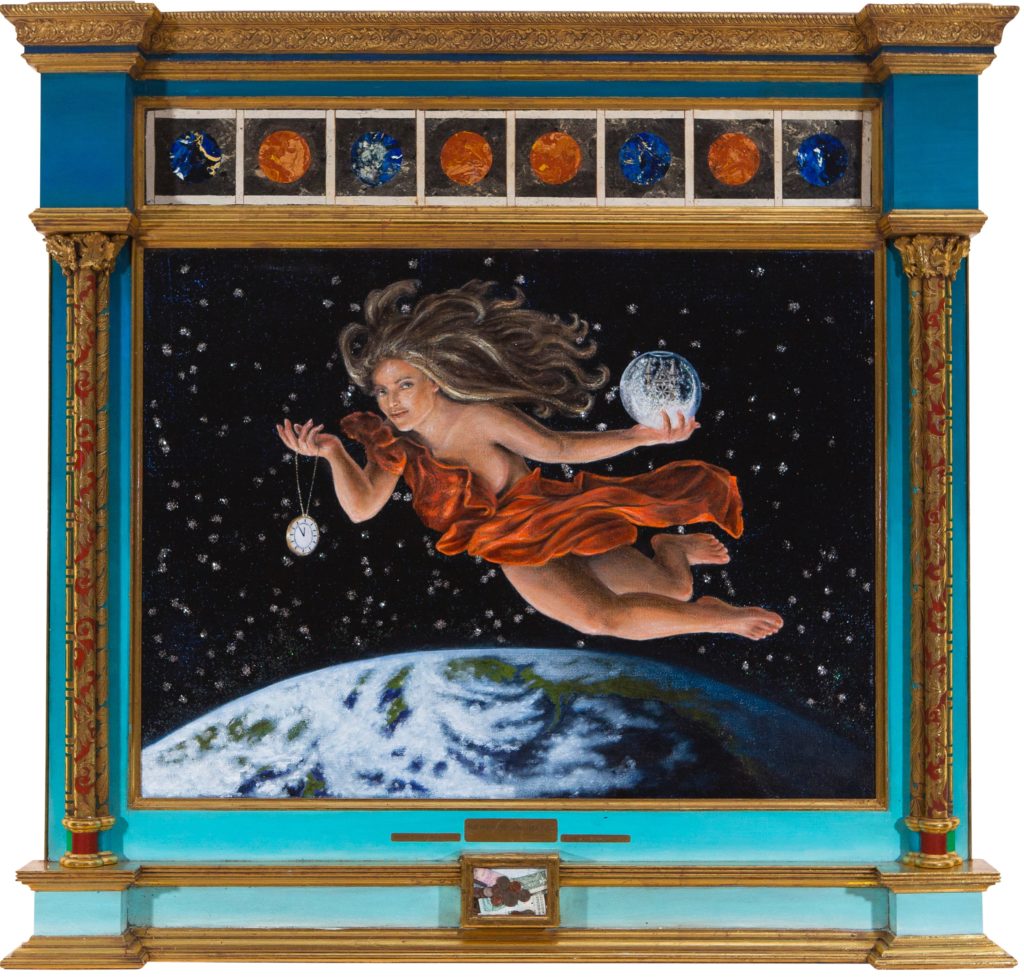
Climate History
Delving into the extended history of climate change is crucial. Understanding the Earth’s past temperature fluctuations enlightens us about the current changes. Media uses science news to attribute human activity as the cause of climate change. It is a mis-conclusion from limited and faulty data, and it’s our job to uncover the truth. It is true that mankind, with its industry, farming, and food production methods, produces many of the gases implicated in global warming. However, the effect these have on the climatic cycles may be minimal. Mankind may be speeding up the cycle, but analysis may show we might be slowing it down.
Climate Cycles
The vanishing of permanent sea ice in the Arctic Ocean and the melting ice sheets in the Antarctic and Greenland are not just atypical signs of climate change. They are part of a broader natural cycle. Understanding these cycles can help us feel reassured that there is a pattern to global warming, and it’s not just a random, catastrophic event. The prevailing study of climate change focuses on short-term terms of under 10,000 years and usually looks at 2 to 5,000 years. However, to comprehensively understand climate change, we must look at the Earth’s 100,000-year warming and cooling cycles. This shift is pivotal in gaining a profound understanding of how climate works and must include the periodic sequence(self-repeating) changes in levels of oceans and Arctic precipitation, which affect ocean currents and ice buildup in the Arctic. The global warming we are experiencing started 20,000 years ago, at the end of the last ice age. The great ice sheets began to melt as the Earth started to warm. This melting caused the ocean levels to rise, flooding low-lying areas of the continents. Rising oceans have enabled warm southern currents(relative to the temperatures of the Arctic Ocean) to enter the Arctic Ocean, increasing the melting of sea ice. Over the last 400 thousand years, there has been a cycle of warming and cooling at least four times. Each warming period, lasting between 14 and 20 thousand years, is separated by much longer ice ages, lasting as much as 80,000 years. This repetition is not a coincidence.
Greenhouse Gases and Ice Core Samples
Blaming man for the current warming cycle is based on comparing the high levels of greenhouse gases like carbon dioxide and methane with past levels. Past levels of greenhouse gases are recorded in air bubbles trapped in ice core samples. However, it’s essential to be critical and analytical about this data. The ice core from both Greenland and Antarctica shows melt layers, which is ice formed after the snow melts, posing a problem in accurately measuring the atmospheric composition at the warmest periods of a climate cycle. The melt water, which later froze, could not hold air bubbles. Hence, ice core samples cannot measure the atmospheric composition at the warmest periods of climate history.
The Arctic Ocean
The Arctic Ocean is distinctive due to its almost landlocked nature and narrow, shallow Bering strait. The Bering Strait, a mere 55 miles wide, is home to the two Diomedes islands. These islands, one Russian and one American, are only 2 1/2 miles apart. This unique geography, with its narrow and relatively shallow strait with underlying continental shelves, sets the Arctic Ocean apart.
With the Arctic Ocean projected to be ice-free in the summer, easterly winds will pick up significantly more water vapor. Many regions of the Arctic receive an annual precipitation of under 10 inches (25 cm), with some areas having as little as 3 inches( 7.6 cm), which is drier than deserts like the Sahara. Once the Arctic Ocean is free of ice, precipitation patterns will change. We may expect rainfall levels similar to those on Canada’s Pacific coast. In some areas, like Ocean Falls, annual precipitation exceeds 172 inches or 430 cm, translating to over 143 feet if it falls as snow.
Arctic Seasons
Arctic summers will warm, but the winters will remain extremely cold, especially away from the coast. Snow and rain will fall in significant quantities, and any standing water in the fall will freeze, and ice, which takes much longer to melt in the warm but short summers, will persist into winter. As the accumulation builds, the quantity of water stored on land will, over time, gradually lower sea levels.
The Bering Land Bridge
Lower sea levels will expose the land bridge in the Bering Strait. This dry land will act as a barrier preventing the relatively warm Pacific currents from entering the Arctic Ocean. The Bering Strait’s role in regulating the Arctic Ocean’s temperature and currents is paramount.
When the Bering Strait no longer lets water from the Pacific from entering the Arctic Ocean. The Arctic Ocean will still produce precipitation as the winds travel across the water, lowering the level of the Arctic Ocean. The Arctic Ocean will replenish the water lost to evaporation from the Atlantic. Currently, Atlantic currents do not flow into the Arctic Ocean. However, to equalize ocean level, currents from the Atlantic will flow into the Arctic Ocean. They will keep the warmer Atlantic flowing into the Arctic Ocean, keeping the sea ice melting during the summers. As more and more snow and ice accumulate, holding water on the land in the Arctic world, ocean levels will continue to drop. With no water entering the Arctic Ocean from the Pacific Ocean, only narrow channels between the continental plates between Greenland and Norway, and insufficient water entering from the Atlantic, the Arctic Ocean will freeze year-round.
When The Arctic Ocean Freezes
The frozen Arctic Ocean will no longer be able to supply moisture for precipitation to the Arctic, and the ice sheets will slowly start to recede until the warmer waters from the Pacific Ocean once again enter the Arctic, melting the ocean ice and restarting the cycle.
Rises and Falls Are Not Smooth
The cycles of temperature and ocean levels do not follow a smooth trajectory. Numerous factors overlooked for simplicity in this analysis influence the rise and fall of temperature and sea levels. For instance, volcanic activity can lead to significant drops in temperature. Meanwhile, the rapid release of meltwater from large post-ice age lakes, such as Lake Agassiz—a proglacial lake from the late Pleistocene— can quickly raise ocean levels. Additionally, human activity plays an undeniable role in these fluctuations. However, these factors do not alter the more significant 100,000-year cycle.
The world has been heating up for the last 18,000 years. Current global warming is part of a cyclical pattern going back hundreds of thousands of years. History shows that climate change may well be independent of human-produced industrial emissions and greenhouse gases.
The ice on the Arctic Ocean was measured over 60 years ago. Since then, the ice has reduced in thickness from fifty to eighty percent, and this speed of thinning has also accelerated. The rapid melting would indicate that global warming will continue and accelerate. History shows that an Arctic Ocean free of summer ice and trees growing on its shore signals the beginning of another ice age.
Global warming is part of a cyclical pattern that dates back hundreds of thousands of years. As a result, human-produced industrial emissions and greenhouse gases will not affect the grand cycle of climate change. Mankind may be slowing down or speeding up the inevitable.
Global warming is not a recent phenomenon. The current melting of the continental ice sheets started 18,000 years ago, and this melting has caused the Oceans to rise over 300 feet. This rise in ocean levels has also accompanied rising ocean temperatures, similar to the last interglacial period. These higher levels have allowed warm ocean currents from the Pacific to cover the Bering shelf and enter the Arctic Ocean. These currents (smaller arrows)are warming the Arctic Ocean and melting the ice that once covered it year-round.
The map of the Arctic Ocean shows the different currents. The warm surface currents from the Pacific Ocean (smaller arrows coming through the Bering Staite) are melting the ice from east to west. The cold current ( heavier arrows) is deep. The rotation of the Earth results stops the Atlantic currents from easily entering the Arctic Ocean, as seen by the hydrological fronts that are shown in orange.
The currents of the Arctic Ocean
The area north of the Arctic Circle currently gets little precipitation, often less than 10″ a year, about the same as the Sahara desert. The Arctic stays frozen for much of the year and, because of this, does not seem dry. ( One inch of precipitation is about 10 inches of snow.) The winds blowing across the frozen Arctic Ocean cannot pick up much moisture from the ice. Therefore, the winds deposit less ice and snow on the continents than the continental ice sheet loses through summer melting. With the Arctic Ocean free of ice for part of the year, precipitation will increase as it is starting to do. Please look at the article in National Geographic April I, 2021, by Madeleine Stone. The article explains that the winds are picking up more moisture, changing the precipitation in Greenland and northern Europe. This increase in precipitation is just the beginning.
This map shows both the deep and shallow currents in the Arctic Ocean as well as the fronts where the currents stop
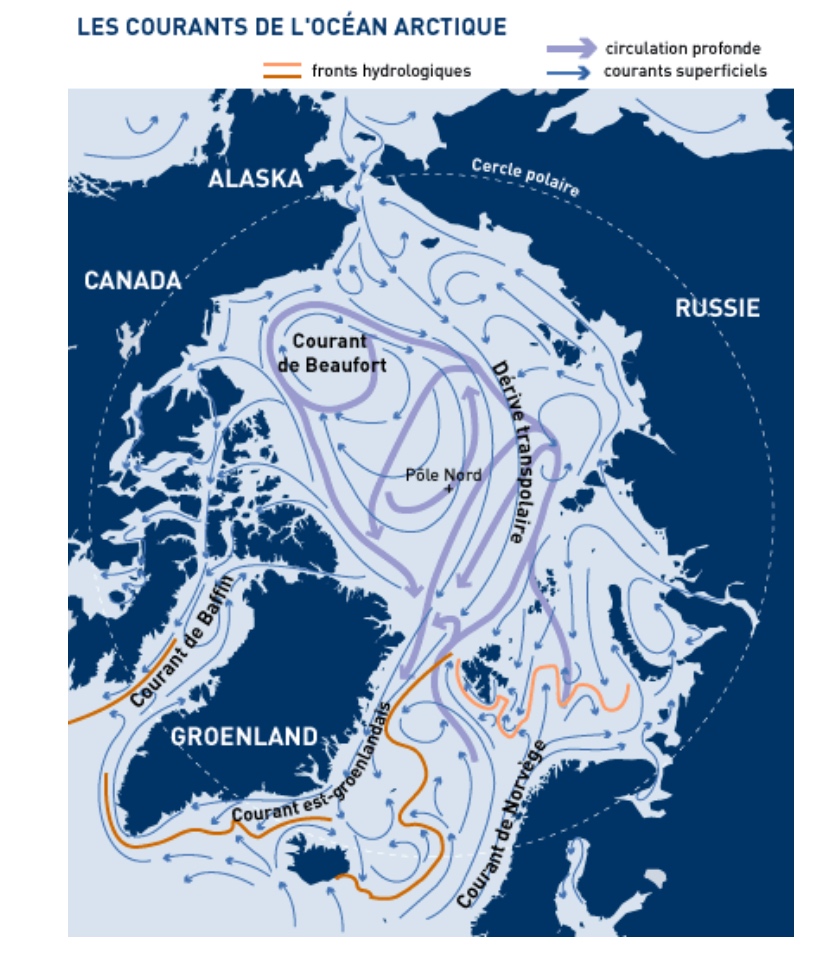
Origin of Layers In the Arctic Ocean
Arctic Ocean Is Almost Landlocked
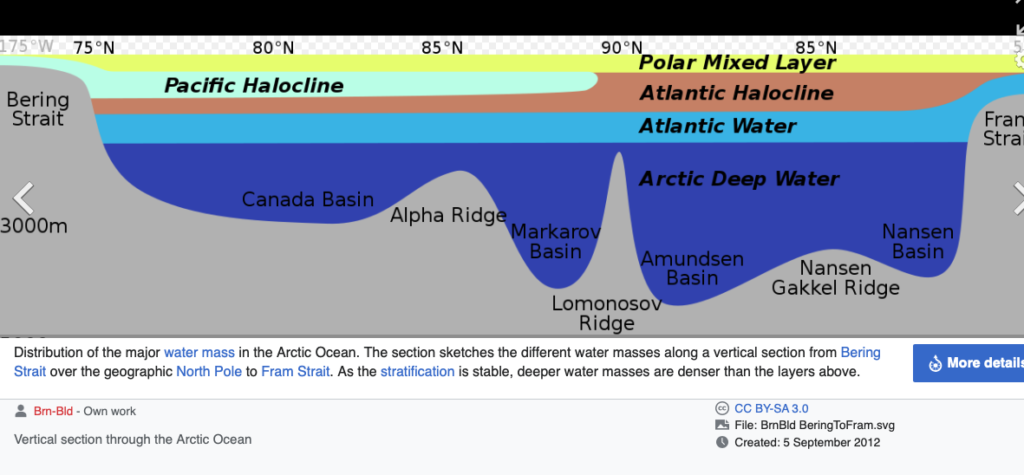


The Sky Is Falling
Description Of Painting
The painting “The Sky Is Falling” is named after an English folktale. The composition shows Lucia (Goosey Lucy) and Penelope (Henny Penny) approaching the King with samples of industrial pollution: carbon dioxide, methane, and chlorofluorocarbon. Science has blamed these chemicals for the depletion of the ozone layer and global warming but is ignoring some important facts.
Details of Painting and Frame


The Rising Levels Of Greenhouse Gases
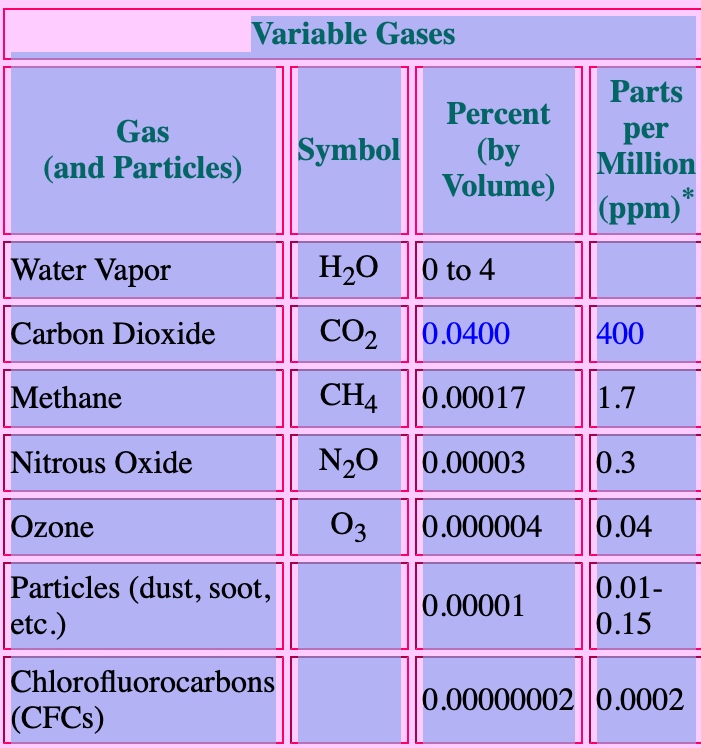
Water vapor is the most abundant greenhouse gas.
However, unlike other greenhouse gases, which are stable under normal atmospheric conditions, it is produced when water changes from a liquid to a gas. This change cools the atmosphere. But the atmosphere’s temperature also controls its ability to hold water vapor. Warm air holds more water vapor, which will cause the atmosphere to warm even more. Understanding these complexities is only the start of grasping the science of climate change. Studying an extended time frame over the past 20,000 years shows that the Earth has been warming. During the same period, sea levels climbed by 400 feet (120 meters). Continental ice sheets melted, and glaciers retreated, reducing the energy and heat reflected into space. Continental shelves that were dry land are now underwater, increasing ocean water’s evaporation into the atmosphere. This heating all happened before man had any significant polluting effect. Soon, there will be a dramatic increase in water vapor entering the atmosphere as the Arctic Ocean becomes ice-free. Humidity and precipitation will increase substantially—the first step in the start of another ice age.
Looking at climate history over 400,000 years shows patterns that indicate current climate warming is part of a cycle that has been repeated at least four times
Ozone Holiday

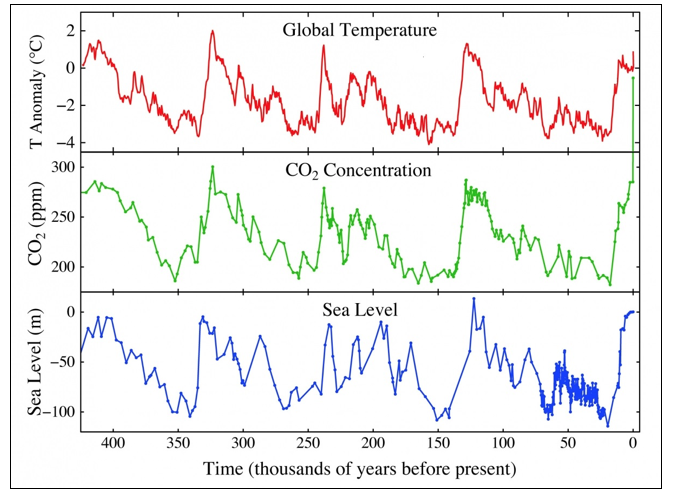
The Advantages Of Ozone Depletion
The Sun’s ultraviolet light hitting oxygen molecules in the stratosphere creates ozone, a crucial shield against damaging ultraviolet radiation. Studies of the ozone in the stratosphere implicated chlorofluorocarbons in destroying ozone. Chlorofluorocarbons, once hailed as a technological marvel, became the subject of intense controversy during the 1970s and 1980s.
Understanding the ozone layer and the ozone hole over the southern hemisphere involves more than simply taking air samples in the stratosphere. Ozone concentrations increase in the daytime, fall at night, and change seasonally. Science believes this pollutant causes the ozone hole, an area in the southern hemisphere almost without ozone.
Measuring the chemical over a few years does not prove a cause-and-effect correlation. Recently, the ozone hole has grown and shrunk, sometimes almost disappearing.
Montreal Protocol in 1967 was an international treaty to phase out the substances science believed to deplete the atmospheric ozone. As far as ozone depletion is concerned, the thinning of the ozone layer throughout the 1980s stopped in the early 1990s, too soon to credit the Montreal Protocol. A 1998 World Meteorological Organization (WMO) report said, “Since 1991, the linear downward trend observed during the 1980s has not continued, but total column ozone has been almost constant …” The same report noted that the stratospheric concentrations of the offending compounds were still increasing through 1998. This finding lends credence to the skeptical view, widely derided at the time of the Montreal Protocol, that natural variations better explain the fluctuations in the global ozone layer.
The current theory, which attributes ozone loss in the upper atmosphere to human activity, specifically the use of fluorocarbons, has been linked to the ozone hole in the southern hemisphere. However, it’s important to note that the hole began shrinking before any changes in aerosol use, introducing a level of uncertainty to our understanding. The ozone layer experiences diurnally and seasonally natural fluctuations, which are unrelated to human behavior. But due to the amount of sunlight that changes oxygen into ozone. Longer cycles may be the cause of the ozone hole. Blaming mankind for all of Earth’s problems is a prevalent trend and may lead to errors in our thinking. For example, in the future, mankind may consider global cooling a success because of our current limits on carbon emissions. However, it could be the first step toward rapidly descending into another ice age.
Scientific conclusions about ozone depletion, chlorofluorocarbons (CFCs), carbon dioxide, and methane are not about blind acceptance. History is littered with the same scenario: the once derided proved correct. They are about all of us, including you, the reader, playing a crucial role in interpreting these findings. Doubting and questioning is the scientific method. Maintaining a healthy skepticism is a shared responsibility in our pursuit of truth and understanding, and you are an integral part of this mission.

Rain Catchers
Rain Catchers Testing Acid, Methane, and Fluorocarbons. The tests of today tell us nothing of yesterday or tomorrow.

Oedipus And The Sphinx
Oedipus is on the verge of solving the riddle of the Sphinx. His success will lead to tragic consequences, as he will unknowingly fulfill a prophecy by killing his father and marrying his mother. Similarly, our approach to solving the problem of global warming is like a riddle. Acknowledging that the Earth is warming poses a significant challenge, as it could lead to catastrophic outcomes if we attribute climate change solely to human activities. Just as the Sphinx in the story will present new riddles, future climate-related challenges will arise. Unfortunately, our responses may come too late to prevent civilizations’ collapse and countless lives lost.
Jupiter, Mercury, And Virtue
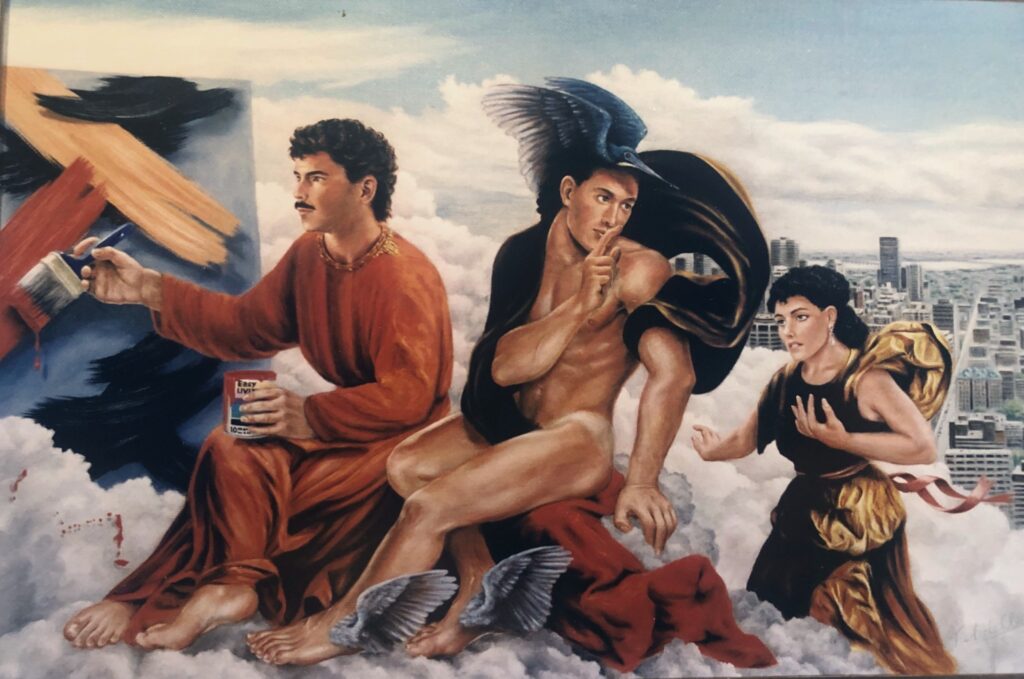
An updated version of the painting by Dosso Dossi, completed in 1524, is set in the clouds above Montreal. In the painting, Virtue is appealing to the gods concerning the challenges faced by humanity and our cities. Should she also be pleading about the pollution and toxins that mankind is releasing into the clouds? Will her appeals be heard, and will the Age of Aquarius finally commence? Jupiter is painting with a can of Sears Easy Living paint, disregarding the splatter he is creating on the clouds. Do Mercury’s tan lines reflect a modesty that his posture does not indicate?